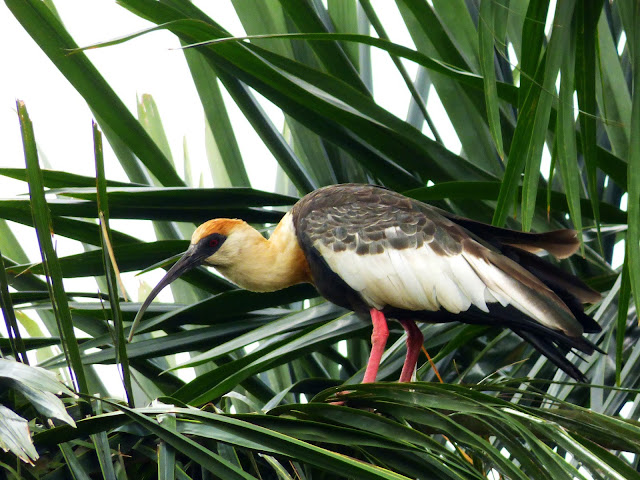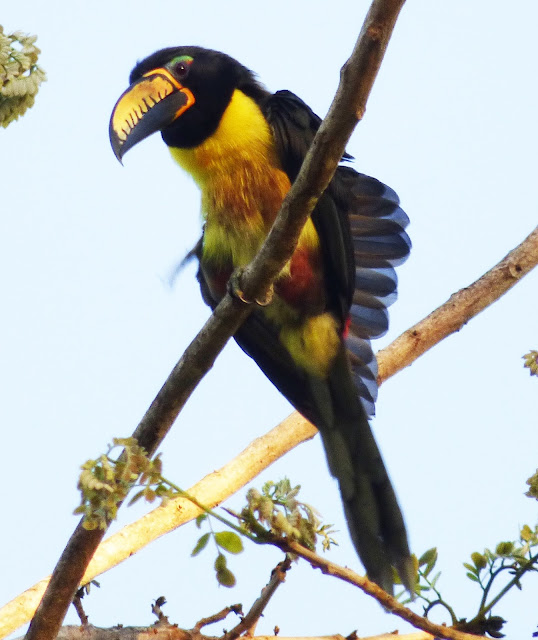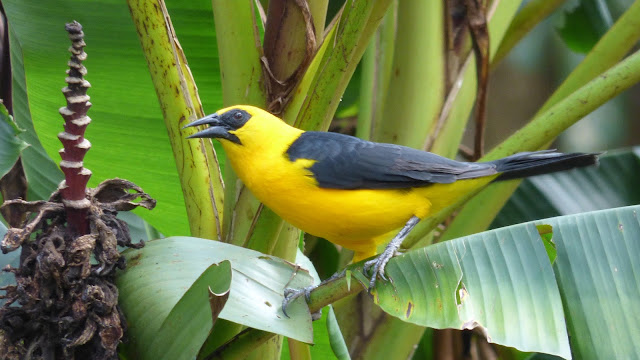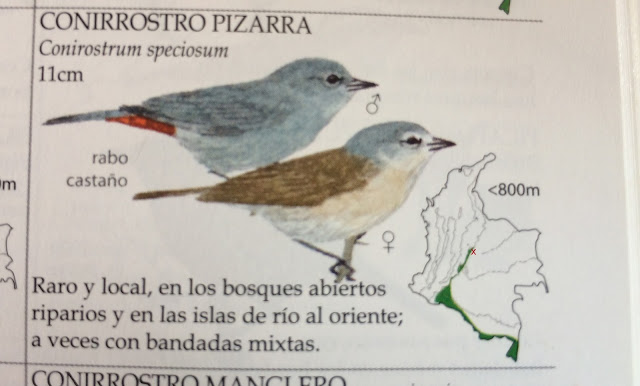After escaping Bolivia, where we knew nobody and where friendly faces were few and far between, we were glad to be greeted at the airport in Asuncion by a high school friend of Natalia’s. Juanjo was not a birder, but with unbridled enthusiasm woke up pre-dawn to take us to some ecoturism spot outside of the city that sounded promising.
'Ecotourism,' turned out to mean 'zip lining,' and also 'by reservation only,' which of course we had not made. There were some trees around the entrance and the bleary-eyed on-site manager was nice enough to let us bird the vicinity until the paying guests began arriving. Since we were blind being led by the blinder we didn’t exactly rack up a huge species count. Nevertheless, crossing paths with a few flocks gave us our first taste of some of the Atlantic Forest Avifauna.
 |
| Blue-naped Chlorophonia |
 |
| Guira Cuckoo |
Paraguay sits at an odd ecological crossroads. It harbors vast areas of arid scrubby savanna known as Chaco, as well as wetter seasonally flooded cerrado-like savanna and then its forests represent the westernmost extent of the Atlantic Forest, famous for being all but destroyed in Brazil and hosting the highest density of endangered birds in the world. This confluence of ecosystems yields an astonishing diversity of bird life and Paraguay’s country list is impressive, given that it is small, nearly flat and much of its territory lies south of the Tropic of Capricorn.
We were eager to continue onward to northern Argentina to delve deeply into Atlantic Forest birds, so only budgeted ourselves a single guided day-trip in Paraguay. In retrospect this was probably a mistake. It would have been great to take a few days to go deep into the Chaco. Luckily it is possible to get a sampling of Chaco, wet savanna and Atlantic Forest all within an hour or so of Asuncion.
So we booked one long day with a local guide. Unfortunately, the ornithologist Alberto Esquivel, wasn’t available, so he set us up with an ‘apprentice guide’ who would take us up to the flooded savannas of Arroyos y Esteros and then down to 'Chaco I'.
Just as incredible as the bird life was the ineptitude of our guide, Jose. We had been warned that he was an ‘apprentice,’ but the frenquency and severity of his misidentifications was truly staggering. As somebody completely new to this avifauna, it took me some time to catch on to his blunders. Here I document no less than 4 brutal errors that are contradicted by photographs.
 |
| Jose called this bird a 'Southern Screamer.' It's clearly a young Great Black Hawk. If he had brought a scope there never would have been any doubt. |
 |
| Jose called this bird a 'Bearded Tachuri,' a bird name I had not previously heard and so didn't recognize immediately how wrong it was. Tachuri refers to a genus of flycatcher; this Long-tailed Reed-Finch is in the tanager family! We saw half a dozen of these and they were all 'Bearded Tachuri.' At least he was consistent. |
 |
| He was right to be calling a lot of Bearded Tachuri, because they were quite common. But with ample chances to recognize the real thing, he instead called this Bearded Tachuri a Euler's Flycatch. |
 |
| At this point I knew Jose was screwing things up as there's no chance this colorful little flycatcher could be an Euler's Flycatcher, which is a forest species and wouldn't be at happily foraging in roadside scrub. So I made a special effort to get some decent photos... |
 |
| And then finally, we saw this fledgling Grassland Sparrow get fed by a parent. Jose's call? 'My gosh it's a Bearded Tachuri with pigment abnormalities!' I shit you not. This is when it dawned on me that Jose was a crap guide and we were being scammed. Hang on... it will get worse. |
All of these mis-identifications Jose dutifully submitted to eBird and shared. After a lot of post-hoc editing I ended up with a much different list.
How many other mistakes did he make that will never be realized? How much bad data is he submitting to eBird? How many false lifers is he foisting upon visiting birders?
 |
| Jose might have correctly identified this Southern Scrub Flycatcher; he did call one out at some point. But after all the struggle with Tachuris, it seems just as likely that he was looking at a Small-billed Elaenia or a White-crested Tyrannulet when he made the call. |
In Chaco-I, the birds were no less abundant and interesting. At some unassuming overgrown intersection behind a gas station we came across an active mixed flock of a few dozen species (including a nemesis of mine: Red-billed Scythebill) during what is typically the midi-afternoon doldrums.
 |
| Rusty-collared Seedeater |
 |
| Nanday Parakeet |
By this point I think Jose began to realize that it was better to be inconclusive with birds rather than make blatant mis-identifications...possibly because I was taking photos. He puzzled a good while over a bird that Natalia and I later realized was a Firewood Gatherer.
And Jose took incompetence to a new level struggled as he drove us into a cow pasture mud pit where we would burn the prime late-afternoon hours unsuccessfully trying to dig his car out.
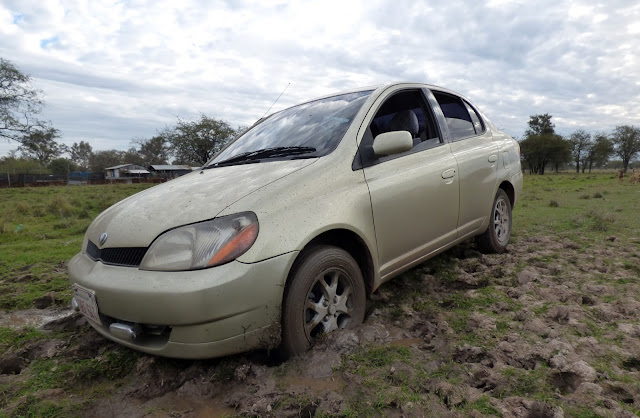 |
| Jose's talents weren't limited to bird misidentification |
Eventually he called his father who came with an SUV and a rope to pull us out. By this point it was long-dark and we were hungry. Jose got lost on the way back to Juanjo's place and our dinner plans had to be cancelled. So it goes.
Don’t get me wrong, Jose was a really nice guy, but for $200, one expects a few basic features in a bird guide, all of which Jose lacked:
1- A spotting scope for appropriate open habitats
2- A good sense of time-management and logistics
3- Familiarity with the regularly occurring bird species!
It was like hiring a taxi driver who happened to own pair of binoculars, except that a taxi driver would have the resourcefulness to get his own car out of the mud.
To his credit, Jose did help us see one of our main targets, the Strange-tailed Tyrant. We saw one distant female that we almost certainly would have missed if he hadn’t known where to stop and look.
Because we had never birded South America’s mesopotamia, we racked up loads of lifers (I got 42), but most of these birds are relatively easy to find in appropriate habitat in parts of Brazil and Argentina. Other than the paucity of decent guides, the other drawback to birding Paraguay is that it almost entirely lacks specialties. There is one endemic tinamou that brings in a few world listers, but its taxonomic validity is in dispute.
The lack of important targets and dearth of good flight routes to North America and Europe leave Paraguay as a forgotten corner of the world’s bird continent. This partly explains the trouble with guides…with such little demand, one gets few chances to practice.
It’s a shame that more birders don’t visit Paraguay, both because the birding is excellent and easy and also because the Chaco is rapidly being converted into mono-culture soy plantations, which is a conservation concern.
For better or for worse, Juanjo dropped us at the bus station the next morning for our ride to Ciudad del Este and a trip across the world’s most heavily traveled frontier, the “friendship bridge” to Brazil, which altogether lacks formal regulation. After a long wait in the traffic jam we passed over into Foz de Iguazu and then across the second part of the triple frontier into Puerto Iguazu, Argentina.




























